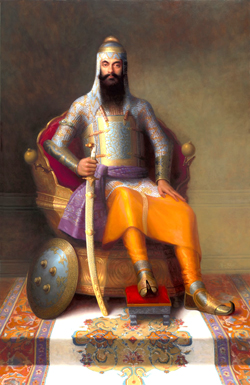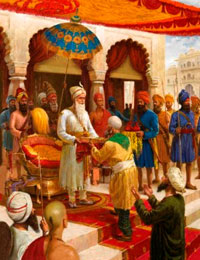Maharaja Ranjit Singh Kingdom
One of the Indians whose impact on the history of the Indian sub-continent has been significantly marginilized is Maharaja Ranjit Singh. Clearly the British historians were partially censurable for this. While many Indians do have admiration for the spirit of adventure and intellect of some of the Britishers during their rule in parts of India , nevertheless, one must remember that the British were there in India mainly to further their interests. It is thus likely that the British may have made an effort to vitiate the achievements of this great Indian as any appreciation of Maharaja Ranjit Singh could have proven to be disastrous for the British during their colonial period in India . Hence, it is long over due that we Indians recognize and appreciate the contributions of this extraordinary Indian.

Like many other things associated with the life of Maharaja Ranjit Singh the date and place of his birth are still a great controversy. Most historians, however, entertain the view that he was born on November 13, 1780 A.D. in Gujaranwala. His father Mahan Singh (a Jat-Sikh) was the chief of the Sukkarchakkia Misl (a Sikh confederacy) with headquarters in Gujranawala. Furthermore, Ranjit Singh was baptized into battle at an extremely young age of 12 years. It so happened that Mahan Singh had laid seize to the fort of Sodrun where Sahib Singh Bhangi of Gujrat had taken refuge after refusing to pay tribute to the Sukkarchakkias. During this seize Mahan Singh was taken ill with chronic dysentery so he handed over the command to his son and he (Mahan Singh) returned to Gujranawala. Subsequently the Bhangi Sardars of Lahore taking advantage of the situation rushed to the relief of Sodrun. Amazingly this boy (Ranjit Singh) cleverly ambushed and defeated the Bhangis. Unfortunately on his return to Gujranwala Ranjit Singh heard that his father Mahan Singh had already passed away. Consequently this lad who spent most of his time hunting was forced to take over the responsibilities of his Misl. Moreover, marriage in 1796 A.D. to Mahatab Kaur who was the daughter of Sada Kaur the leader of the powerful Kanhaya Misl and subsequent marriage to Raj Kaur of the Nakkai Misl enabled Ranjit Singh to gain the loyalty of other powerful Misls. Ranjit Singh who was an extremely ambitious person was now equipped to fulfill his dream of expanding his kingdom.
While Ranjit Singh still faced challenges from other Sikh Misls, however, the greatest challenge to his expansionist ambitions were the Afghans. It must be mentioned that during that period and the period prior to that period dynasties originating from Afghanistan had started making inroads into parts of India . As is well documented that a Buddhist influenced Afghanistan was not able to survive the onslaught of Arab armies for long. Moreover, gradually by the the 10th century A.D. the religion, culture and even to some degree the ethnicity of Afghanistan had started to change as colonies of Arabs settled in Afghanistan. After the Islamization of Afghanistan invaders from Afghanistan frequently pillaged India . Fortunately, due to pressure initially from the Rajputs these invaders were not too successful in forming stable kingdoms in India . Also it was only after the middle of the 18th century (following also the weakening of the Mughal Empire) that the Afghans led by Ahmad Shah Abdali were successful in carving out a kingdom in India . It was thus the descendents and kinsmen of Abdali who posed a challenge to any expansive moves by Maharaja Ranjit Singh particularly in the West and North. In fact Maharaja Ranjit Singh's grandfather the great Charat Singh had already come into conflict earlier with Ahmad Shah Abdali.

While it is impossible as such to mention and describe all the conquests undertaken by Maharaja Ranjit Singh in this article, however, an effort will be made to refer to some of the important ones. The first major conquest that Maharaja Ranjit Singh undertook was not from the Afghans but from his own kinsmen the Sikhs. Lahore during that period was ruled by three Sikh chieftains namely Chet Singh, Sahib Singh and Mohan Singh, whose fathers had wrested this city from the Afghans in 1764 A.D.. The citizens of Lahore who were tired with misrule invited Maharaja Ranjit Singh to take over the city. With the encouragement of Sada Kaur his mother-in-law, Maharaja Ranjit Singh entered Lahore on July 7, 1799 and took the defenders by surprise and thus captured this largest city of Punjab technically without firing a shot. Subsequently at a Grand Durbar on April 12, 1801 A.D., Sahib Singh Bedi a direct descendent of Guru Nanak proclaimed him Maharaja of Punjab. Next Maharaja Ranjit Singh captured the holy city of Amritsar from Mai Sukhan who was the widow of Gulab Singh Bhangi. The exact date of this possession is still controversial but many historians accept a date of February 24, 1805 A.D. However, in no way was Maharaj Ranjit Singh's appetite for conquest satisfied and next this Maharaja embarked on taking over Kasur. Moreover, the Afghan ruler of Kasur Qutub-ud-Din Khan after the death of his brother Nizam-ud-Din Khan had refused to accept the overlordship of Maharaja Ranjit Singh.
Eventually in the year 1807 A.D. Maharaja Ranjit Singh annexed Kasur and also in the same year Bhawalpur was made a tributary. The British alarmed at the rapid expansion of the kingdom of Maharaja Ranjit Singh signed the Peace Treaty of Amritsar in 1809 A.D. with him and SutlejRiver was accepted by Britishers as the eastern boundaries of the Maharaja's territories. Next Maharaja Ranjit Singh annexed the territories of Gujrat, Khushab, Sarhind, Sahiwal etc. Multan was next on the agenda of the Maharaja. The total control of Multan had evaded the Maharaja on six times. Eventually a large force led by Diwan Chand Misr was sent to capture Multan and Nawab Muzzafar Khan of Multan was killed and Multan Fort capitulated on June 2, 1818 A.D. Also one of the childhood dreams of Maharaja Ranjit Singh was to seize Peshawar from the Afghans.
In October 1818 A.D. Maharaja Ranjit Singh marched towards Peshawar from Attock and swiftly occupied the fortresses of Khairabad, Jahangira and Naushera. In the process the powerful Khattak Chief, Feroz Khan was also forced to submit to the Maharaja. Eventually the Sikh forces entered Peshawar on 19th November, 1818 A.D.. The famous and invincible Sikh general namely Hari Singh Nalwa (Uppal) played a key role in the capture of Peshawar. Following this in the year 1819 A.D. a large force led by Prince Kharak Singh (the eldest son of the Maharaja) and Diwan Chand Misr was sent to capture Kashmir from the Afghans. After fierce fighting the Maharaja's Army entered Srinager on July 4, 1819 A.D. Rebellions against Sikh authority in Peshawar occurred in 1823 A.D. and 1827 A.D. The 1823 A.D. rebellion was put down mainly due to the great Sikh warrior namely, Phula Singh Nihang who sacrificed his life in the famous battle of Naushera. The 1827 A.D. rebellion against the Sikh authority which was initiated by the fanatic Muslim Sayyed Ahmad of Barreilly was put down and a force led by Prince Sher Singh (the son of the Maharaja) was also successful in killing the Sayyed and his followers in 1831 A.D..

It was also during the reign of Maharaja Ranjit Singh that a deep thrust by the Indians in the Himalayan territories occurred. Even the great Chandragupta Maurya whose territories included Eastern Iran and the whole of Afghanistan did not undertake such a conquest. It so happened that Raja Gulab Singh a noble of Maharaja Ranjit Singh decided to extend the boundaries of the Maharaja's kingdom to Ladakh etc. In the year 1834 A.D. Raja Gulab Singh commissioned the brilliant and fierce Rajput namely, General Zorawar Singh to lead this expedition. General Zorawar Singh was not only successful in adding Ladakh, Baltistan etc. to Maharaja Ranjit Singh's territories but continued his thrust deep in the Himalayan territories, till his death in Tibet while fighting a joint Sino-Tibetan force. It must be remembered that Tibet was a close ally of China during that period. Starting as a minor kingdom, however, by the time of his death on 27th June, 1839 A.D. Maharaja Ranjit Singh's kingdom extended from Tibet to Sind and from Khyber Pass to the Sutlej River. Prior to his death the Maharaja's Army entered Kabul in 1838 A.D. and installed Shah Shuja as a puppet King of Afghanistan.
Moreover, while Maharaja Ranjit Singh had great respect for all religions, however, he in no way appeased any particular religious group for his personal gains. Nevertheless, this Maharaja took upon himself to reverse any injustice which had been done to India by the Afghans. For instance the Maharaja was able to recover the gates of the SomnathTemple and Kohinoor Diamond both of which had been taken from India by invaders. The former was taken by Mahmud of Ghazni, while the latter was by Nadir Shah of Persia. The gates of the SomnathTemple were eventually brought back by the Maharaja's Army from Afghanistan.
Supposedly the Darshani Gates of the GoldenTemple in Amritsar are the original SomnathTemple Gates. As far as the Kohinoor Diamond is concerned it is well known that it found its way to Shah Shuja the King of Afghanistan. Maharaja Ranjit Singh after capturing Shah Shuja (by means of an an intelligent setup) was eventually able to extract this precious stone from Shah Shuja, though after a lot of effort. Moreover, just before his death Maharaja Ranjit Singh was keen to gift this stone to the JagannathPuriTemple,. however, the ruling chiefs did not approve this.
Maharaja Ranjit Singh was an intelligently aggressive person and this is more than clear from his numerous victories. Each conquest was planned meticulously and his troops were equipped with the state-of-art-weapons. As long as this Maharaja was alive the British had a formidable rival in India. In fact it is widely accepted by experts that the Maharaja even had the capability of defeating the British.
